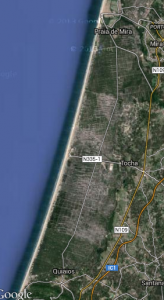Serendipity
We returned from our sea adventures to Coimbra in order to practice a bit more Tango on the lovely band stand. After two days though, rain stopped play, so we are moving on Southwards.
On our way out of the city, we stop by a garage to do a bit more maintenance on Emma. It is great how things just seem to fall into place when you are travelling: the garage is run by a Ukranian called Mikhael who waves us in straight away and gets one of his guys, Francisco, to not only grease the nipples but to give Frank one of those roly things that let you go under the vehicle while lying on your back, so he can see where all the nipples are. In addition, Francisco shows us how to jack up Emma with our newly bought 10 ton jack, in case we need to change a flat tyre. This garage has an unusual feel to it somehow. I can’t put my finger on it. Mikhael runs a tight ship. He’s got four or five men working there, and he walks around watching that everything gets done in the way it should, but everyone seems happy, smiley and busy: there’s a good camaraderie in the air. We leave, very thankful for having come upon a garage which would be so generous as to teach us these invaluable lessons.
Our map of Portugal is spectacularly bad, with many roads and villages missing. This results in us ‘losing the way’ (as if we have a way!), and ending up having adventures.
In this fashion, we stop for the night in a place called Fátima, on a very large car park adjoining a church. Judging by the size of the car park, this must be a very touristic spot. It is pouring with rain, so we defer exploring to the next day.
Fátima is in fact a huge religious centre. We have never seen such a big gathering place – it’s 3 or 4 times bigger than the open space in front of the millennium centre in Cardiff. About 100 years ago, this place was an open field where 3 children had a visitation by a lady dressed in white who appeared in a tree and gave them instructions to come back every 13th of the month to see her. She gave teachings to them, which eventually were written down as a series of secrets to do with our time. The basic message was that love is the most important thing and that we are in an age of choice, where we can freely decide between walking the path of love or of hate. Her invitation was to come to her immaculate heart and be protected by her energy.
Initially the children got into trouble for talking about having had a visitation, but other things happened that confirmed their stories, and gradually people started to believe in them. More and more people turned to this place and its benevolent energy. The lady in white was identified as mother Mary and the adoration grew to such dimensions that she was termed the queen of Portugal.
As it happens we are there on the 13th and a friendly woman, who tells us the history of the place, doesn’t think this is by chance but that ‘the lady’ has called us to her….
We walk around for a while. There are many people here, involved in their various forms of devotion. Some pray, while others walk round the building with long candles that they then offer to a large fire (the whole place smells of burning wax). Some are shuffling on their knees all the way across the big square and around the little chapel. This latter devotion is in memory of Lucia, one of the children, who did this once to pray for her mother’s health when she was very ill. Her mother’s recovery led to the villagers finally believing the children’s story.
We have a look at the graves of the three children and discover that two of them, Francisco and Jacinta, died within a few years of the visitation. Lucia lived on until 2005.
We also have a look at the new church at the other end of the square. A huge round building, which looks quite unapproachable from the outside, but inside it has a lovely atmosphere, open and modern, with light streaming in from the ceiling and a big golden mosaic behind the altar. It is huge – it would sit several thousands of people. There is a service going on and then the statue of the lady is led in a procession back to its little chapel. There is an atmosphere of celebration, of joy. It’s more folksy than religious really. It certainly doesn’t have the usual dark and heavy feeling that catholic churches often have.
It is hard to imagine this place like it was when the original story happened – an open field with just a few trees… of course people had to build the structures to cope with the millions of visitors every year (the nearby town of 8000 inhabitants has a bed capacity for 10 000 guests!), but in doing so they build over the very nature of the experience. I wonder what Lucia thought of all the buildings, the huge square, the car parks etc. By all accounts she was a simple, no-nonsense, down to earth woman. I also wonder why the other two children died so young.
After an hour, Frank and I have had enough. The religious flim-flam fills us both with unease, though I have to say the original story touches my heart and whilst it is serendipitous that we’re there on the 13th of the month, somehow this doesn’t surprise me, it just feels right.
And where did the name Fátima come from? This long predates the religious story. When the Moors were in Portugal, one of the Portuguese princes fell in love with a beautiful girl called Fátima. Love transgresses all boundaries, even those of faith. But the real world caught up with them and Fátima had to convert to Christianity so they could be together. His response to her conversion was to call this place after her, in remembrance of their love.
You can see a few photos of Fátima on our flickr page
Posted in Uncategorizedwith 1 comment.
Sand Dunes and Beach
View more photos of the beach on flickr
Sand dunes and beach
I’ve been longing for sand dunes and beaches, so we take a few days to explore the area north west of Coimbra. We’ve been told there are miles of beach along the coast there…
Indeed, there is sand, wind and waves as far as the eye can see. We stay a couple of nights at various beaches, watch beautiful sunsets and have bracing dips in the sea. It is too wild to go in more than knee-deep. Strong currents pile the sand up in irregular heaps, and breaking waves further out indicate sand banks along the shore. Waves are breaking against each other, and there is a strong pull out into the sea once the waves recede. Having spent all my childhood holidays by a sandy shore in Spiekeroog, on the north coast of Germany and watched people drown almost every year, I have a healthy respect for the power of the sea and make sure that we are safe. It all looks harmless enough, but I know very well that if you go in a few feet deeper, you can easily get knocked over by a wave and pulled out and that’s it – by the time help has been called it’s usually too late.
One night we stay in a forested part of the dunes in the middle of nowhere, on a road parallel to the sea. I’d love to get lost in the sand dunes for an hour or so before we leave I say to Frank the next morning. So we set off. Mushrooms everywhere!!! If only we knew better which ones are edible. We err on the side of caution and leave them all behind. We come across an elderly couple who are ‘hunting’ mushrooms with special implements to dig them up. They are after the kind that only just pop their heads out of the sand, their fleshy stalks remaining hidden. One has to be eagle-eyed to find them!
Then we hear the sea, just behind the next few dunes – or so we think. After one hour of fruitless hunting for the sea, scrambling up sandy dunes and down through very overgrown forests, we come upon a huge sandy track, straight for miles, at the end of which we can just about make out the sea. So we decide to give up and go back home along the track, using the position of the sun as our guide. After about 40 minutes of walking along the track in the heat (and no, we didn’t even have water with us!), we come back out on the road, not too far from where we had parked. Phew! One should always be careful what one wishes for – and be precise! ‘an hour or so’ had turned into a good 2.5hrs.
Later that day, looking at googlemaps satellite pictures, we see that we had only made it halfway through the dunes towards the sea. Lucky we turned around when we did. But isn’t this impressive: this is a place in Europe where there is 40km of beach, in two uninhabited sections of 20km each, and you need to walk through about 8km of forested sand dunes to get there in the first place! I feel like packing a day bag and going there, but Frank has had enough of traipsing through deep sand and undergrowth for hours on end…
Posted in Uncategorizedwith comments disabled.

